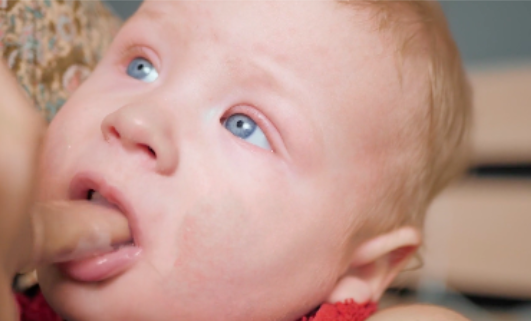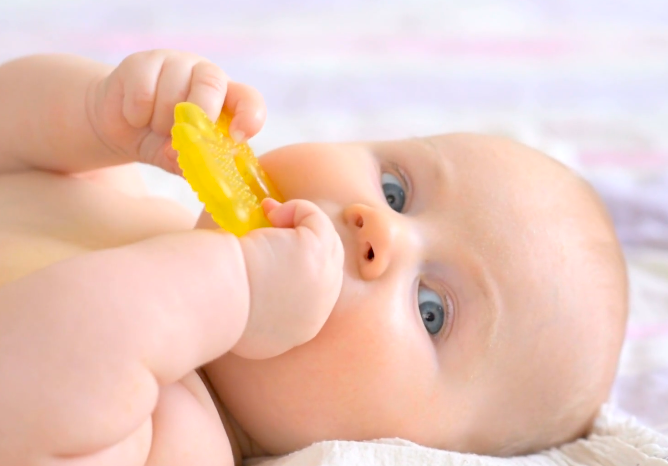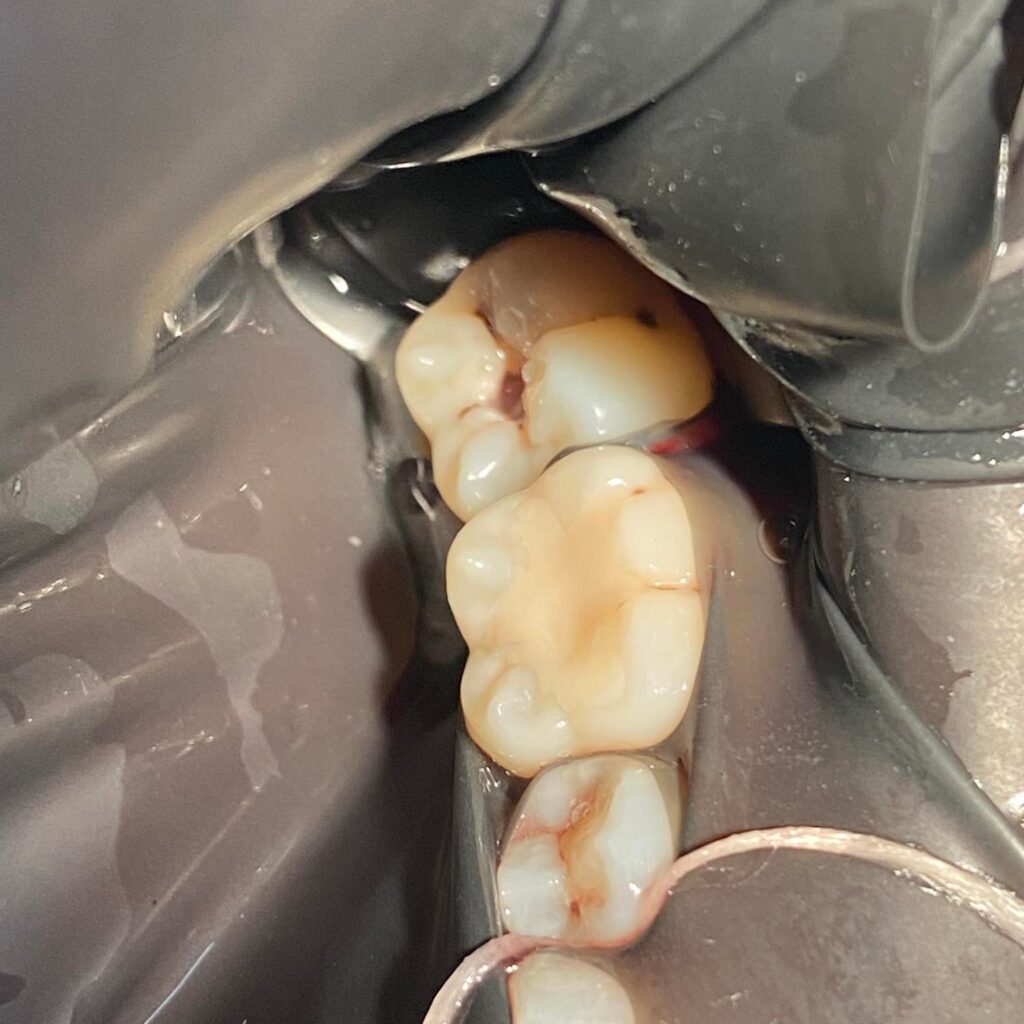The following home remedies are found to be useful to a teething baby:
- Rubbing their gums
- Teething rings
- Cold Food
- Pacifiers
- Use of Spoon
- Clean their gums
At around 6 months of infancy, an important milestone in a baby’s development takes place. While this is an exciting event in a baby’s growth and one that parents eagerly anticipate, it is not one without worries.
The emergence of a baby’s first set of teeth (primary teeth), also known as teething, is marked by a range of symptoms including agitation, biting, drooling, inflamed gums, loss of appetite, and sleep disturbance. It is not uncommon for parents to feel anxious and even confused during this necessary and thankfully, temporary process in their child’s development.
Understanding the teething process includes identifying ways to ease the baby’s discomfort and learning about helpful strategies to make the experience less stressful for both the parent and the child.
Fret not, as there are home remedies to alleviate teething symptoms. Arming oneself with practical tips will surely help the parent provide comfort and support to the teething baby during this challenging stage of the baby’s development.
Rub your baby’s gums

Gently rub your baby’s gums with a clean washcloth or gauze that is cool and damp. Alternatively, wash your hands and rub your baby’s gums with your finger.
Use teething rings

Teething rings aid in massaging the baby’s gums and theoretically provide counterpressure to the rising tooth. Give your baby a cooled (not frozen) teething ring that they could chew safely. This can distract your baby from discomfort or any pain.
Reminders:
- Do not use teething rings that have fluid inside.
- Do not use a teething necklace or tie a teething ring around your child’s neck as this could potentially strangle them.
- Do not place a teething ring in the freezer then give it to your child. Doing so could injure or damage their gums.
- Carefully read and follow the instructions that come with the teething ring to know how long you need to chill it.
Give your baby cold, soft foods.
Teething can negatively affect a baby’s appetite. Although not all babies can experience this, it is still important to know which foods are best for babies when they are teething.
Soft foods that offer minimal contact with the baby’s gums are ideal, such as pureed fruit or pureed vegetables.
Cool foods also offer some relief to their gums. Yogurts and mashed bananas are easy examples of this type of food.

Provide your teething baby with something firm to suck on.

While this appears to contradict the previous recommendation, the firmness of hard foods theoretically counteracts the pressure of the emerging tooth, as is the case with the use of teething rings or teething toys.
Use a spoon

You can use your baby’s weaning spoons to help alleviate the discomfort in your baby’s gums. Gently run the back of a cold weaning spoon along your baby’s gums. A weaning spoon is designed for little mouths and little gums so you can guarantee your baby’s safety while making use of this method.
Comfort your teething baby
You can distract your baby by playing with them or by cuddling them. Massaging them also helps. Skin contact between parent and child helps babies feel calmer.
Help your baby get to sleep
Be aware of your baby’s sleep patterns. You can play white noise when getting your baby to sleep as this can also distract them from any gum pain they are experiencing. Ideally, anything that can emit blue light (such as a TV or a phone) must be turned off at night to promote melatonin production and not interfere with it so that your baby can enjoy a good sleep. You may also massage your baby before bed to soothe them.
Clean your baby’s gums

Did you know that daily brushing should start even before your baby gets their first tooth? According to the American Association of Pediatric Dentists (AAPD), it is recommended that your baby’s gums are cleaned two times a day with a soft cloth or a baby toothbrush and water. This also allows the parent to establish good oral habits with their child early on.
Additionally, it is not recommended to let your baby fall asleep with their mouth unclean, such as in the case of them falling asleep with a bottle containing milk or sugary fluids. Doing so puts them at risk of developing cavities. If your baby feels comfortable falling asleep with a bottle, ensure that the bottle contains only water.
Avoid using topical anesthetics.
The AAPD warns of using topical anesthetics such as over-the-counter teething gels to relieve pain in a teething baby due to the potential toxicity of these products in infants.
While it is useful to know about home remedies for this matter, it is also of equal importance that a parent knows of professionally-discouraged practices such as this one. If your baby’s condition has become severe, it is always sensible to bring them to your nearest pediatrician or healthcare provider.
In conclusion
Teething is a natural process that is characterized by new teeth breaking out of your child’s gums. Because it is associated with varying symptoms from excessive salivation to excessive crying resulting in restlessness in the baby and the parent, navigating through this can be arduous.
A parent who is informed and seeks advice from healthcare professionals while providing comfort and care to their little one can infinitely make this chapter go smoothly. Fundamentally, at the heart of this is the desire to provide care to the teething baby to the best of the parent’s abilities.
Never forget that your love and support for your little one are the most precious tools you have as you traverse through this exciting and sometimes intimidating time.
Sources:
Plutzer, K., Spencer, A. J., & Keirse, M. J. N. C. (2012). How first‐time mothers perceive and deal with teething symptoms: a randomized controlled trial. Child: care, health and development, 38(2), 292-299.
NHS. (n.d.). Tips for helping your teething baby. NHS choices. https://www.nhs.uk/conditions/baby/babys-development/teething/tips-for-helping-your-teething-baby/
NCT (National Childbirth Trust). (2019, July 15). Feeding and teething: How to help them with the pain: Baby & Toddler Articles & Support: NCT. NCT (National Childbirth Trust). https://www.nct.org.uk/baby-toddler/teething/feeding-and-teething-how-help-them-pain
American Academy of Pediatric Dentistry Clinical Affairs Committee–Infant Oral Health Subcommittee, & American Academy of Pediatric Dentistry Council on Clinical Affairs. (2005). Guideline on infant oral health care. Pediatric dentistry, 27(7 Suppl), 68-71.
Teething. Nationwide Children’s Hospital. (n.d.). https://www.nationwidechildrens.org/family-resources-education/health-wellness-and-safety-resources/helping-hands/teething



